This article summarizes the simulated crop stages and yield forecasts performed on Aug. 16 for 40 locations across the U.S. Corn Belt using the UNL Hybrid-Maize crop model; the data can be seen in Table 1. Details on the underpinning methodology to simulate phenology and forecast end-of-season yields, as well as on interpretation and uses of yield forecasts, are described in a previous article.
During the last two weeks, solar radiation was above the historical average in sites located in NE and KS while below average records were registered in IL and OH. The remaining sites presented near average values. Daily air temperature was well above average in NE, KS and IA, while nighttime temperature was near historical records in the entire Corn Belt. In the case of rainfall, most locations exhibited below-normal records, except for sites in MN and in the central and eastern part of the region (IN, IL, MI and OH) where precipitation was near or above normal. A summary of weather conditions during the last two weeks is shown in Figure 1.
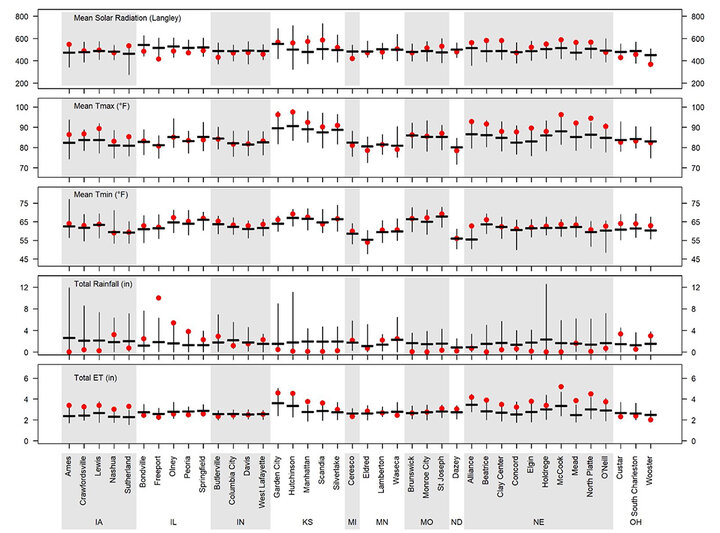
Table 1. Data from simulations of 2022 end-of-season corn yield potential and real-time crop stage performed on Aug. 16.
| Location | Water regime | Long-term average yield (bu/ac) § | Range of Yp forecasts as of Aug 16 (bu/ac)¶ 25th | Range of Yp forecasts as of Aug 16 (bu/ac)¶ 75th | Probability (%) of 2022 yield to be: Below (relative to the long-term Yp)† | Probability (%) of 2022 yield to be: Near (relative to the long-term Yp)† | Probability (%) of 2022 yield to be: Above (relative to the long-term Yp)† | Simulated current crop stage* | |
|---|---|---|---|---|---|---|---|---|---|
| NE | Alliance | Irrigated | 193 | 177 | 194 | 12% | 82% | 6% | R4, Dough |
| Beatrice | Dryland | 161 | 111 | 119 | 100% | 0% | 0% | R5, Dent | |
| Irrigated | 230 | 196 | 205 | 84% | 16% | 0% | R5, Dent | ||
| Clay Center | Dryland | 157 | 78 | 94 | 100% | 0% | 0% | R4, Dough | |
| Irrigated | 245 | 225 | 241 | 20% | 80% | 0% | R4, Dough | ||
| Concord | Dryland | 174 | 97 | 118 | 100% | 0% | 0% | R4, Dough | |
| Irrigated | 249 | 229 | 253 | 12% | 85% | 2% | R4, Dough | ||
| Elgin | Irrigated | 252 | 230 | 250 | 21% | 74% | 6% | R4, Dough | |
| Holdrege | Dryland | 113 | 88 | 105 | 68% | 32% | 0% | R5, Dent | |
| Irrigated | 242 | 241 | 258 | 0% | 88% | 12% | R4, Dough | ||
| McCook | Dryland | 88 | 35 | 35 | 100% | 0% | 0% | R5, Dent | |
| Irrigated | 225 | 186 | 192 | 100% | 0% | 0% | R5, Dent | ||
| Mead | Dryland | 182 | 122 | 143 | 98% | 2% | 0% | R4, Dough | |
| Irrigated | 235 | 205 | 223 | 42% | 58% | 0% | R5, Dent | ||
| North Platte | Dryland | 90 | 46 | 56 | 98% | 2% | 0% | R4, Dough | |
| Irrigated | 234 | 220 | 241 | 8% | 90% | 2% | R4, Dough | ||
| O'Neill | Irrigated | 227 | 207 | 226 | 24% | 70% | 5% | R4, Dough | |
| IA | Ames | Dryland | 229 | 179 | 203 | 79% | 21% | 0% | R4, Dough |
| Crawfordsville | Dryland | 230 | 136 | 153 | 100% | 0% | 0% | R4, Dough | |
| Lewis | Dryland | 209 | 138 | 158 | 96% | 4% | 0% | R4, Dough | |
| Nashua | Dryland | 228 | 230 | 252 | 3% | 70% | 27% | R3, Milk | |
| Sutherland | Dryland | 210 | 142 | 173 | 97% | 3% | 0% | R4, Dough | |
| IL | Bondville | Dryland | 235 | 214 | 236 | 17% | 80% | 3% | R4, Dough |
| Freeport | Dryland | 212 | 234 | 252 | 0% | 25% | 75% | R4, Dough | |
| Olney | Dryland | 190 | 204 | 212 | 0% | 69% | 31% | R5, Dent | |
| Peoria | Dryland | 211 | 219 | 236 | 0% | 66% | 34% | R4, Dough | |
| Springfield | Dryland | 179 | 225 | 234 | 0% | 0% | 100% | R4, Dough | |
| IN | Butlerville | Dryland | 224 | 209 | 219 | 5% | 95% | 0% | R4, Dough |
| Columbia City | Dryland | 224 | 231 | 243 | 0% | 79% | 21% | R4, Dough | |
| Davis | Dryland | 231 | 219 | 236 | 0% | 100% | 0% | R4, Dough | |
| West Lafayette | Dryland | 238 | 202 | 221 | 47% | 53% | 0% | R4, Dough | |
| KS | Garden City | Irrigated | 218 | 178 | 180 | 100% | 0% | 0% | R5, Dent |
| Hutchinson | Dryland | 100 | Black layer on Aug. 2. Final yield: 61 bu/ac | Matured | |||||
| Manhattan | Dryland | 136 | Black layer on Aug. 13. Final yield: 156 bu/ac | Matured | |||||
| Scandia | Dryland | 131 | 62 | 86 | 100% | 0% | 0% | R4, Dough | |
| Irrigated | 226 | 231 | 249 | 0% | 69% | 31% | R4, Dough | ||
| Silverlake | Dryland | 141 | 145 | 147 | 0% | 100% | 0% | R5, Dent | |
| Irrigated | 209 | 213 | 218 | 0% | 100% | 0% | R5, Dent | ||
| MI | Ceresco | Dryland | 180 | 196 | 221 | 0% | 33% | 67% | R2, Blister |
| MN | Eldred | Dryland | 115 | 101 | 139 | 38% | 23% | 38% | R3, Milk |
| Lamberton | Dryland | 212 | 201 | 223 | 16% | 84% | 0% | R4, Dough | |
| Waseca | Dryland | 219 | 236 | 265 | 0% | 38% | 62% | R3, Milk | |
| MO | Brunswick | Dryland | 181 | 136 | 177 | 50% | 50% | 0% | R4, Dough |
| Monroe City | Dryland | 174 | 198 | 215 | 0% | 10% | 90% | R4, Dough | |
| St. Joseph | Dryland | 167 | 187 | 212 | 0% | 18% | 82% | R4, Dough | |
| ND | Dazey | Dryland | 109 | 90 | 132 | 41% | 22% | 37% | R3, Milk |
| OH | Custar | Dryland | 208 | 214 | 235 | 3% | 59% | 38% | R3, Milk |
| South Charleston | Dryland | 216 | 220 | 244 | 0% | 66% | 34% | R4, Dough | |
| Wooster | Dryland | 210 | 210 | 237 | 3% | 59% | 38% | R2, Blister | |
§Long-term (last 20-plus years) potential yield at each location and surrounding area.
¶ Range of forecasted 2022 potential yields based on average planting date in 2022, indicating the potential yields in the 25th and 75th percentile of the potential yield distribution (associated with respective adverse and favorable weather scenarios during the rest of the season).
† Probability of obtaining a 2022 yield below (10%) than the long-term potential yield at each location.
Simulated Corn Stage Across 40 Locations
Corn has reached dough stage in a majority of sites, except for those in the northern and eastern fringes of the region. Due to high temperatures, corn has even reached kernel dent stage in the southern fringe of the Corn Belt (KS and southern NE and IL) and black layer at two sites in KS (Figure 2). Locations in the north and eastern fringes of the Corn Belt are behind last year’s corn development due to late planting (see forecasts for Aug. 4, 2021 and Aug. 25, 2021).
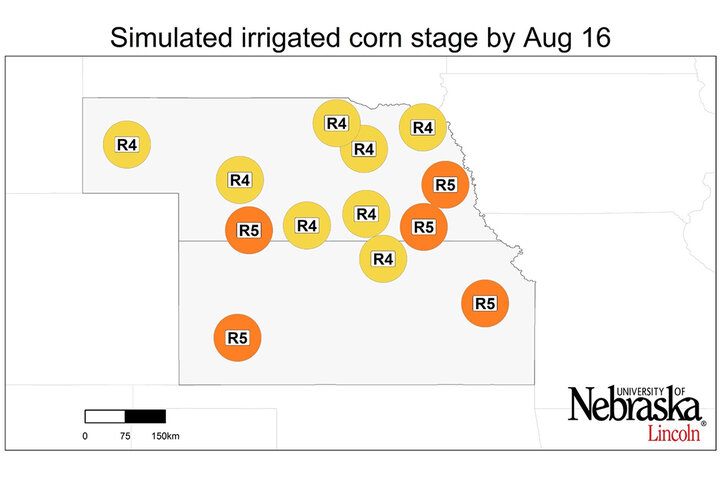
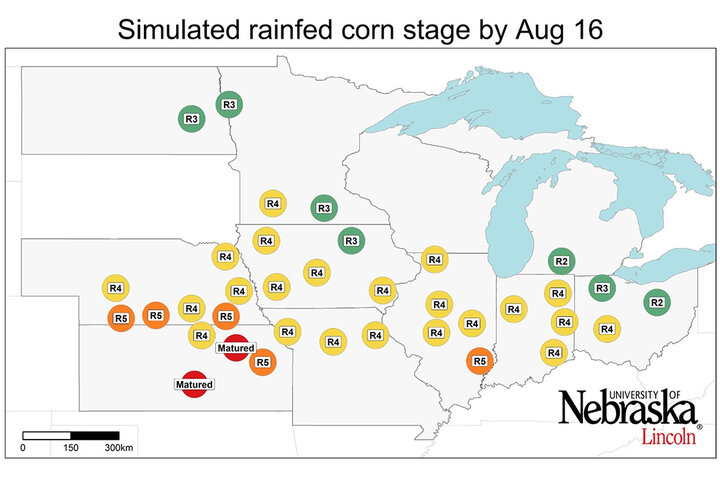
Irrigated Corn: Near or Below-average Yields are Expected
The range of forecasted irrigated corn yield potential for each location, as well as the probabilities for yields above, near, or below average, are shown in Figures 3 and 4. Most irrigated sites (seven out of 13) exhibit a high probability (>75%, that is, three out of four chances) of near-average yield potential. Three sites located in southern NE and southwestern KS exhibit a high probability of below-average yield potential. Overall, the forecasted scenario for irrigated maize yield potential in the current season seems similar to the 2021 forecasted yield but 5% lower than the long-term average.
Rainfed Corn: Yield Potential is Highly Variable Across Rainfed Sites
Compared with our previous forecast, below-average rainfall during the past two weeks in most sites in NE, KS and IA increased the probability (>75%, that is, three out of four chances) of below-average yield potential in those states. Overall, 11 sites distributed in NE, KS, and south and west of IA have a high probability of below average yields. In contrast, a high probability of above average yield potential is expected in five scattered sites in the southern fringe of the Corn Belt (KS, MO and southern IL) and north of IL (Figures 3 and 4) because of sufficient rainfall and near-normal temperature. Probability of near-average yield is high at six sites mostly located in the eastern part of the Corn Belt (IN and IL). Overall, the forecasted regional average yield for rainfed maize in 2022 seems similar to that forecasted in 2021 but 7% lower than the long-term average.
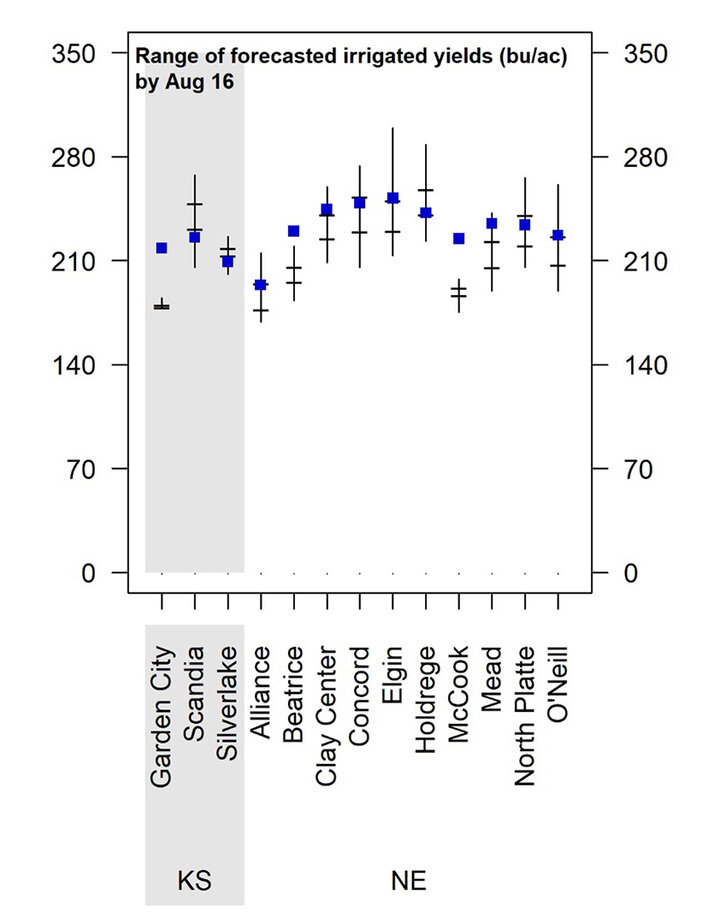
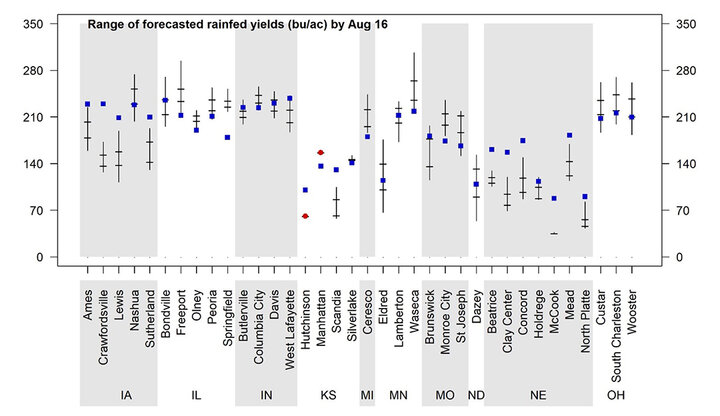
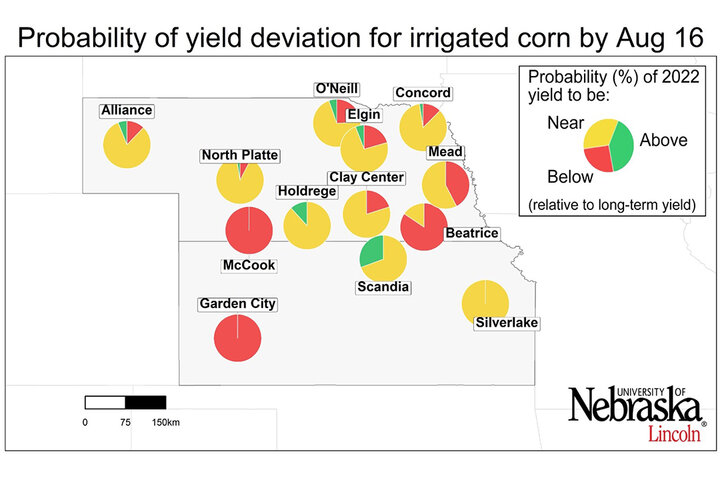
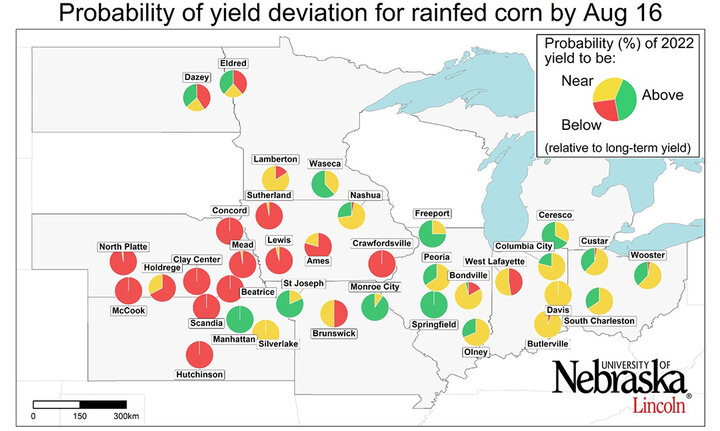
Conclusions
Corn has already reached the dough stage in most parts of the Corn Belt, while dent stage (or even black-layer) has been reached in a few sites in the southern fringe of the region. Compared to our previous forecasts, there is a higher probability of below-average yields for both irrigated and rainfed corn, especially in the western fringe in the region. Overall, the regional average yield is expected to be 5% (irrigated corn) and 7% (rainfed corn) below the historical averages, which differs from USDA yield forecasts that predict 2022 corn yield to be similar to the average during the 2015-2021 period.
These forecasts do not take into consideration problems with stand emergence, hail/flooding damage, replanting situations, disease or nitrate leaching. In fields negatively affected by these constraints, actual yields will be lower than estimates provided here. It is important to keep in mind that yield forecasts are not field specific and, instead, represent an estimate of average on-farm yield for a given location and surrounding area in absence of the yield-reducing factors mentioned here. Likewise, crop stages and forecasted yields will deviate from those reported here in fields with planting dates or hybrid maturities that differ markedly from those used as the basis for these forecasts. We will follow up with the final forecasted yield and analysis of the 2022 crop season in September.
